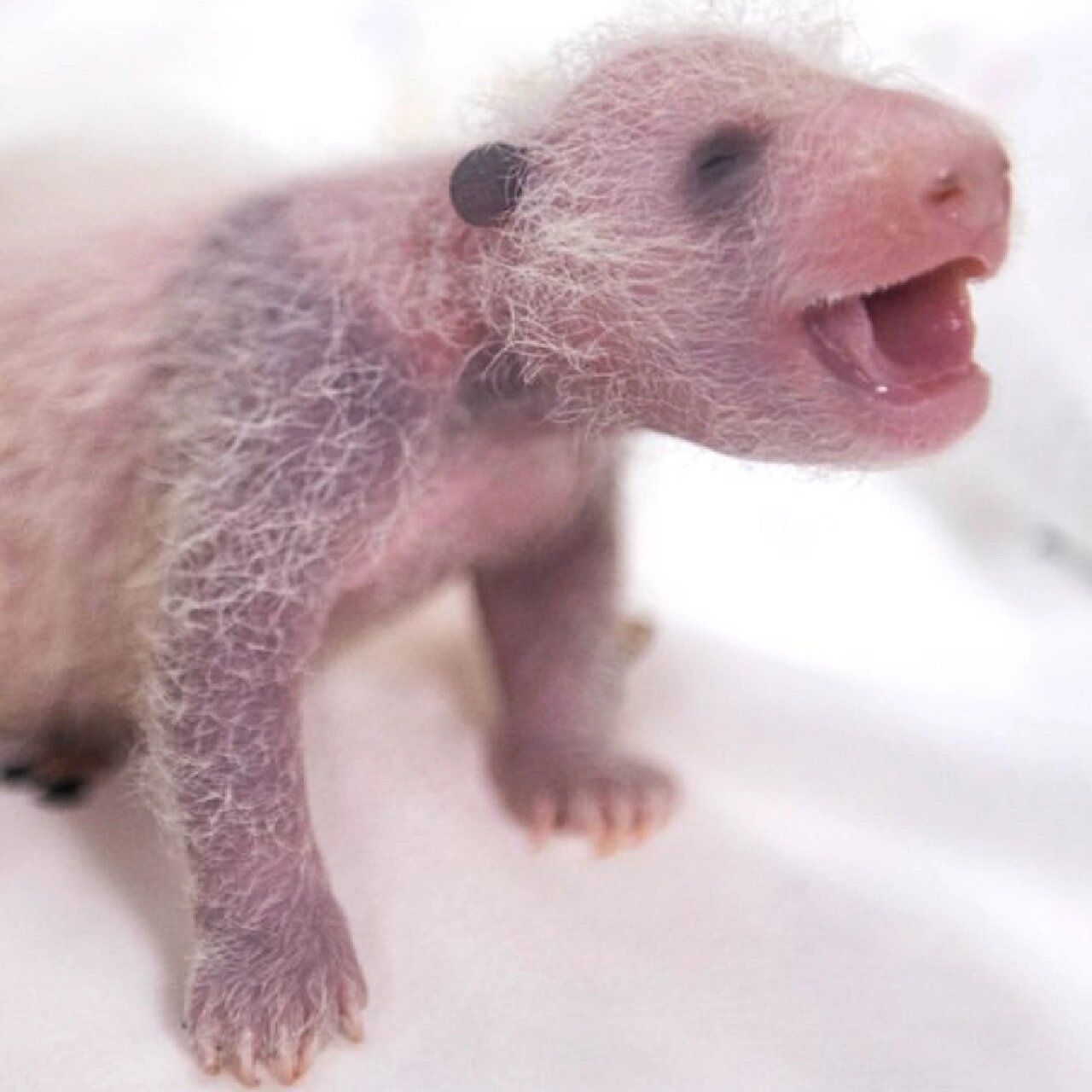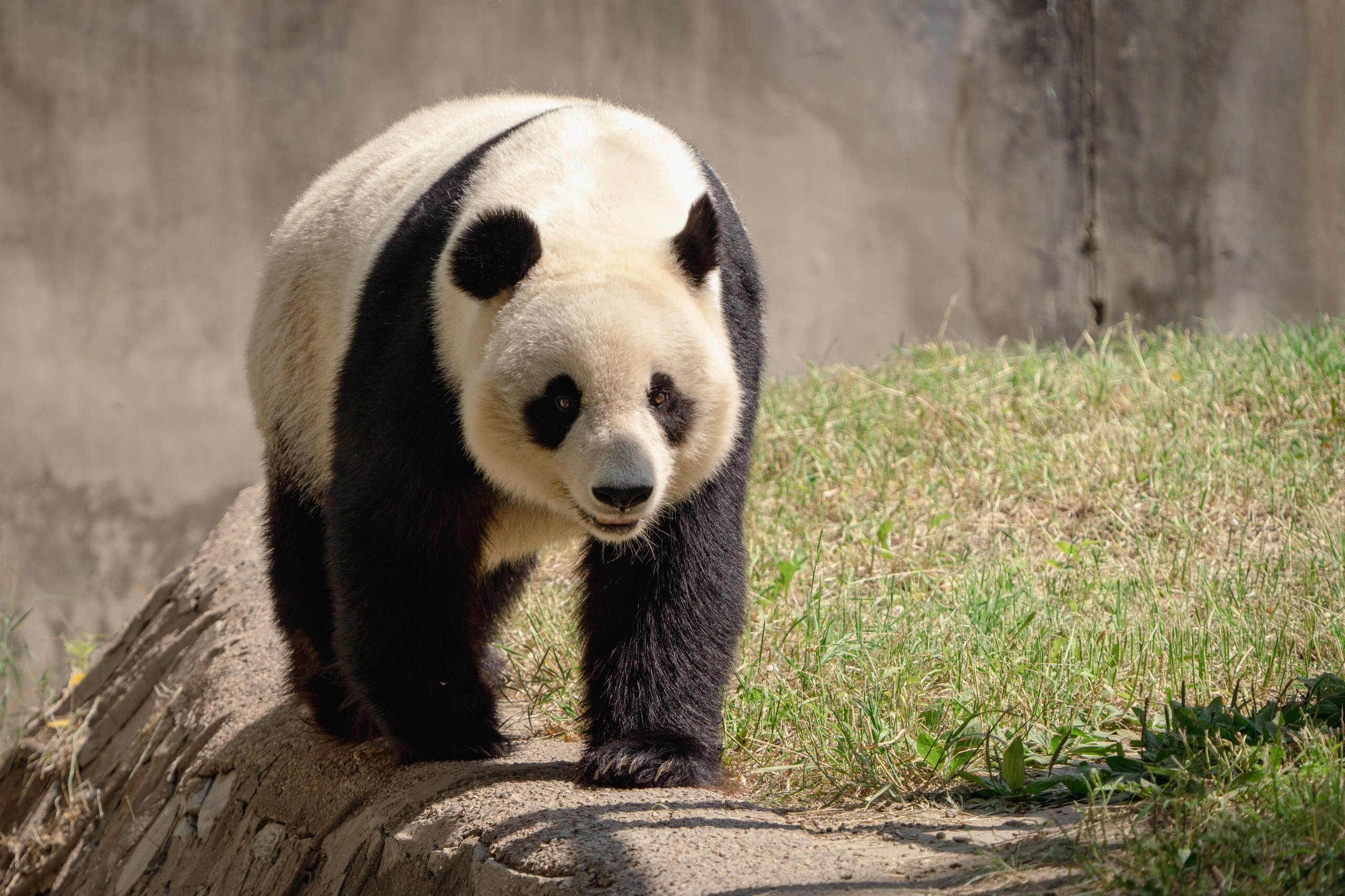Are Giant Pandas Naturally Adorable?
What may seem like cuteness overload to the average person actually holds scientific explanations in the eyes of zoologists.
In March 1869, the French missionary and biologist Armand David, located in Sichuan, obtained a peculiar animal pelt from a hunter in Baoping County, Ya'an. It was black and white in color, resembling a bear. Consequently, David named it "Ursus Melanoleucus" in Linnaean taxonomy, commonly referred to as the "black-and-white bear." Later, he sent more specimens of this animal to the distinguished figure at the French National Museum of Natural History, A. Milne-Edwards. After meticulous examination, Edwards published "On Several Animals from Eastern Tibet," stating that while its appearance resembled a bear, its skeletal structure and teeth differed from bears but were closer to those of the red panda and raccoon. Thus, he proposed renaming the "black-and-white bear" as the "cat-footed animal," leading to the origin of the Chinese term "cat bear.
The transformation from "cat bear" to the later "panda" supposedly originated from an amusing misunderstanding: In the 1940s, during the inaugural exhibition of a giant panda specimen at the Beipei Natural Museum in Chongqing, the labeling, possibly done by Westerners or heavily influenced by Western conventions, listed the Chinese and Latin names from left to right. However, at that time, people traditionally read from right to left, thus pronouncing "cat bear" as "panda." Since then, the term "panda" has become the official name for this species.
Although the name was established, debates among biologists arose regarding its taxonomic classification. In 1929, British biologist R.I. Pocock suggested that the prominent bare area at the tip of the giant panda's nose, lacking the transverse groove seen in bear species beneath the nostrils, similar lengths of front and hind limbs, and the presence of larger pads on the front paws were distinctive enough to differentiate it from bears and raccoons, warranting its classification as a separate family, the Ailuropodidae. However, others believed that due to six similarities between the giant panda and the red panda, there might be a close relationship, suggesting its placement within the raccoon family.
American biologist D. Dwight Davis, based on anatomical studies, proposed that the giant panda was a highly specialized bear. Therefore, it could be classified within the bear family, or by acknowledging its differences from bears, could constitute a separate family. Chinese biologist Pan Wenshi, after comparative research, concluded that the giant panda should be classified within the bear family but proposed an independent subfamily, Ailuropodinae, within the bear genus – a conclusion supported by contemporary scientific evidence derived from chromosomal banding studies of giant pandas and bears.
The mere task of naming and classifying has left biologists scratching their heads, indicating that the giant panda is not only distinct in appearance but also a uniquely singular animal in the field of zoology. Its unconventional characteristics make it an inevitable and globally renowned superstar.

The 'Cuteness Factors' of Giant Pandas in the Eyes of Biologists
Why Are Giant Pandas So Adorable?
Ordinary people might say that giant pandas are cute because they appear chubby and clumsy in their movements, with their big, round ears and distinct black patches against white fur creating an adorable contrast. However, biologists offer a rather unromantic "straightforward" explanation: Pandas don't have a particularly large body size; their endearing demeanor stems from their inward-facing limbs, leading to a wobbly gait. Their large, round ears enhance their auditory sensitivity, while their rounded head shape results from a shorter snout compared to other bear species. The distinctive black eye patches serve to camouflage poor eyesight, while their black fur adapts them to cold environments by absorbing heat and facilitating better peripheral blood circulation. In short, they didn't evolve to be irresistibly cute just to attract audiences.

A giant panda cub in an incubator at the Chengdu Research Base of Giant Panda Breeding in Sichuan, China, is opening its mouth and squealing.
In fact, within the bear family, giant pandas don't stand out in terms of body size. Wild giant pandas weigh approximately between 60 to 73 kilograms, with the heaviest reaching 110 kilograms. They typically measure 120 to 180 centimeters in length, 65 to 75 centimeters in shoulder height, 87 to 89 centimeters in chest circumference, and 64 to 65 centimeters in hip height. Their hind legs span from 12 to 20 centimeters, ears measure 7.2 to 11.5 centimeters, and their tails range from 11.5 to 20 centimeters. Size-wise, they're roughly on par with medium-sized Asian black bears but nowhere near the stature of dominant bear species like brown bears and polar bears.
In comparison, artificially raised giant pandas tend to have larger body sizes, typically reaching around 80 to 125 kilograms. The heaviest recorded giant panda was "Ping Ping," gifted to the Moscow Zoo in May 1957. Hailing from Baoping County, Ya'an, "Ping Ping" and "Qi Qi" were the first "diplomatic gifts" presented abroad by the newly established People's Republic of China to the Soviet Union. Enjoying exceptional treatment in Moscow, "Ping Ping" was fed a diet consisting of 2 kilograms of oatmeal or milk-cooked porridge, 100 grams of sugar, 400 grams of fruit juice, 500 grams of bamboo shoots and leaves, 2 eggs, as well as favorite juices, sweet tea, carrots, and tender branches of birch and willow trees. Consequently, "Ping Ping" astonishingly reached a weight of 181.5 kilograms, setting a record.
Compared to other bears, giant pandas are not adept at running and jumping. Their movements often appear clumsy and gentle due to their inward-facing limbs. From an evolutionary perspective, this characteristic likely evolved as a result of their predominantly bamboo diet, which didn't necessitate hunting. Nevertheless, while giant pandas may not move as agilely as other carnivorous animals, being bear species, they possess highly flexible joints throughout their bodies. They exhibit unexpected actions such as using their mouths to groom their hip and tail areas and performing acrobatics in trees. In the wild, they demonstrate not only adept climbing skills but also the ability to navigate moss-covered cliffs and even swim across rivers like the Pi River in Wolong County, the Baishui River in Qingchuan County, and the Fu River in Pingwu County. However, during flash floods, their abilities are limited.

The giant panda "Xile" at Tianjin Zoo.
One of the reasons giant pandas appear to have round heads is due to their shorter snouts. However, despite the appearance, their short snouts are densely packed with well-developed chewing muscles, granting them impressive bite force capable of breaking bamboo and even iron. Nevertheless, their lip shape "betrays" their bear lineage: a short, vertical groove along the midline of the upper lip leading directly to the nasal septum, resembling a cleft lip, with a nose pad resembling that of a cat. These features significantly differ from those of bears. Additionally, compared to bears, giant pandas have relatively larger nasal cavities, an adaptation to their high-altitude, thin-air habitat.
To the general public, one of the giant panda's endearing features is its distinct black-and-white fur. However, this striking coloration raises the question: isn't it too conspicuous in the wild? Surprisingly, in their natural habitat of high-altitude environments with temperatures around 10°C and humidity between 70% to 80%, the black-and-white fur actually offers protection. The contrasting colors serve as effective camouflage in densely forested or snowy regions. Furthermore, these environments often experience rainy or snowy conditions, which might seem harsh for other animals but are quite comfortable for giant pandas due to their robust black-and-white fur. This fur is coarse, long, resilient, evenly distributed, with black fur on their buttocks and back measuring approximately 35 to 45 millimeters long, 50 to 70 millimeters on the back and shoulders, and up to 100 millimeters on the chest and abdomen. Beneath their fur, giant pandas have a layer of skin varying from 4 to 6 millimeters thick, with the thickest pad skin reaching 1 centimeter. This skin layer contains elastic fibrous connective tissue and abundant sebum and skin gland secretions, offering protection to their fur and allowing them to comfortably rest in snowy environments without fearing danger. Ultimately, on mountainous terrains, it's challenging for predatory animals to maintain body temperature, let alone engage in vigorous hunting – an unnecessary task for the predominantly herbivorous giant pandas, whose low body fat content doesn't entice predators.
 and George Schaller discovered the birthing den of the giant panda Zhen Zhen in a hollow tree in the wild.jpg)
"Hu Jinchu" (left) and "George Schaller" discovered the birthing den of the giant panda "Zhen Zhen" in a hollow tree in the wild.
In conclusion, what may seem like the adorable aspects of giant pandas to the general public has scientific explanations in the eyes of biologists. When people understand the zoological principles behind these adorable traits, they might secretly acknowledge that while giant pandas might seem to rely on their cuteness for survival, the many endearing aspects of their appearance have evolved as unique adaptations to their environment.

A close-up of a panda eating bamboo in the Wolong National Nature Reserve in Sichuan.
"Home-Loving Dwellers" Who Enjoy Playing and Roaming
People love giant pandas not only for their adorable appearance and actions but also for other factors. For instance, when observing them in zoos, it's evident that they are always playful whenever they're awake. Whether climbing up and down wooden ladders, rolling around with a tire, or exhibiting a carefree demeanor, they often entertain audiences, eliciting hearty laughs.
In fact, it's natural for giant pandas to enjoy playing, even in their wild habitat. Zoologists have observed that after satisfying their hunger and thirst, wild giant pandas engage in various games. They slide down slopes on grass or snow, frolic in rivers, and sometimes even venture into villages, taking local farmers' buckets and containers as toys, only to casually discard them on the mountainside after playtime, showcasing their playful and curious nature.

A giant panda is playing in a tree in the Wolong National Nature Reserve in Sichuan, China.
Despite their playful nature, giant pandas tend to lead a rather solitary existence, marking their territories with excrement to delineate their activity areas. When other pandas detect these markings, they tend to actively avoid the area. Encountering other pandas is a rare occurrence, and even zoologists have difficulty locating them. To track and study wild giant pandas, researchers made considerable efforts. In the late 20th century, they conducted radio-tracking studies on five giant pandas—three females named "Long Long," "Ning Ning," "Zhen Zhen," and two males named "Wei Wei" and "Han Han"—within the Wolong Nature Reserve. Taking advantage of reduced winter food resources, researchers set up eight capture points using barbecued lamb and pig bones as bait. Once captured, they anesthetized the pandas using Ketamine or a mixture of Ketamine and Xylazine (Rompun), conducted routine measurements, fitted them with radio collars, and monitored them using fixed antennas positioned on prominent ridges and
handheld antennas. After two years of extensive monitoring—recording data at least every 15 minutes for a minimum of five full 24-hour days each month—scientists finally gained preliminary insights into the activity patterns of wild giant pandas.
From monitoring results, the giant panda's activity range, referred to as their "home range," spans approximately 4 to 7 square kilometers, typically around 6 to 7 square kilometers for males and 4 to 5 square kilometers for females. Within this limited area, giant pandas conduct their daily activities such as foraging, drinking, seeking mates, and reproduction, displaying a notably more "homely" nature compared to other bear species. In contrast, a bear of similar size, like the black bear, typically has an activity range several times larger, and in some cases, exaggeratedly up to ten times more extensive.
However, giant pandas can expand their activity range if necessary. Scientists observed "Tang Tang" from the Tangjiahe National Nature Reserve in Guangyuan, Sichuan, setting a record with an exaggerated 23.1 square kilometers. This exceptional expansion occurred due to the blooming and subsequent die-off of the bamboo species, forcing "Tang Tang" to venture above 2600 meters from June onward to find edible bamboo. Yet, when considering its actual core activity area, it didn't exceed 1.1 square kilometers.

On January 27, 2018, a wild giant panda was captured by an infrared camera wandering in the snowy terrain within the Baishuijiang National Nature Reserve in Gansu Province, China.
Interestingly, although giant pandas generally prefer solitary lives, they seem to have a longing for "social interaction." Monitoring five pandas in the Wolong Nature Reserve, scientists discovered that their home ranges overlapped within an approximately 30 to 40 square kilometer range. Not only did they keep each other company, but their activity areas also had overlaps, notably among the male pandas. Surprisingly, "Long Long" and "Wei Wei" had half of their home ranges overlapping. Additionally, they frequently visited other female or sub-adult pandas, perhaps to establish familiarity. However, female pandas, engaging in fewer activities, tended to be more dispersed, with less obvious overlap in their home ranges. Despite their desire for social interaction, male pandas tended to avoid direct encounters, marking areas with excrement until the scent dissipated, allowing other males to enter. If by chance two male pandas met, the weaker one typically chose to retreat.
It's worth noting that despite the giant pandas wandering around the mountains, they are profoundly attached to their homes and often tend to spend their entire lives within their familiar territories. In one observation instance at Wolong, scientists were noticed by "Zhen Zhen." It frequently visited the observation site seeking food and eventually became reliant on human-provided sustenance, altering its feeding behavior and activities. To minimize interference with wild animals, the staff had to relocate it over 5 kilometers away to Yingxiong Gou. Unexpectedly, within 10 days, it crossed mountains to return home and even revisited the observation point, requesting human-provided food. Helpless, the staff made a firm decision, moving it 10 kilometers east of its original territory. Surprisingly, observations revealed it was steadily moving westward, ultimately spending 39 days traversing dense virgin forests to return to its cozy abode. This unexpected event led scientists to discover that giant pandas possess remarkable navigation skills. They hypothesized that "Zhen Zhen" likely relied on its keen sense of smell, along with wind patterns and celestial navigation, to successfully return to its familiar habitat.

References:
Hu Jinchu's "Giant Panda Research"
Du Youshun's "Research on Giant Panda Feeding Management and Disease Prevention in Wuhan Zoo"
David Wildt, Anju Zhang, etc.'s "Giant Pandas: Biology, Veterinary Medicine, and Management"









